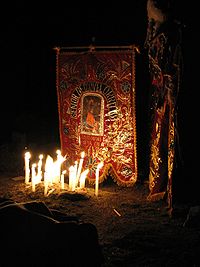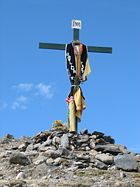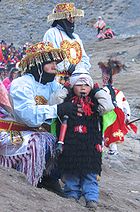
Qoyllur Rit'i
Encyclopedia

Cusco Region
Cusco is a region in Peru. It is bordered by the Ucayali Region on the north; the Madre de Dios and Puno regions on the east; the Arequipa Region on the south; and the Apurímac, Ayacucho and Junín regions on the west...
of Peru
Peru
Peru , officially the Republic of Peru , is a country in western South America. It is bordered on the north by Ecuador and Colombia, on the east by Brazil, on the southeast by Bolivia, on the south by Chile, and on the west by the Pacific Ocean....
. According to local traditions, the celebration originated in 1780, when a young native herder called Mariano Mayta befriended a mestizo
Mestizo
Mestizo is a term traditionally used in Latin America, Philippines and Spain for people of mixed European and Native American heritage or descent...
boy, called Manuel on Mount Colquepunku. Thanks to Manuel, Mariano's herd prospered so his father sent him to buy clothes for the two boys in Cusco
Cusco
Cusco , often spelled Cuzco , is a city in southeastern Peru, near the Urubamba Valley of the Andes mountain range. It is the capital of the Cusco Region as well as the Cuzco Province. In 2007, the city had a population of 358,935 which was triple the figure of 20 years ago...
. Mariano took a sample of Manuel's clothes but could not find anything similar because that kind of cloth was only worn by the archbishop. The latter sent a party to investigate but when they tried to grab Manuel, he became a bush with an image of Christ hanging from it. Thinking they had harmed his friend, Mariano died on the spot and was buried under a rock. An image of Christ painted over this boulder became known as the Lord of Qoyllur Rit'i which means Lord of Star Snow.
The Qoyllur Rit'i festival attracts a large number of peasants from the surrounding regions divided in two moieties. Paucartambo groups Quechuas
Quechuas
Quechuas is the collective term for several indigenous ethnic groups in South America who speak a Quechua language , belonging to several ethnic groups in South America, especially in Peru, Ecuador, Bolivia, Chile, Colombia and Argentina.The Quechuas of Ecuador call themselves as well as their...
from the agricultural regions to the northwest of the sanctuary while Quispicanchis includes Aymaras from the pastoral regions to the southeast. Both moieties make an annual pilgrimage to the feast bringing large troupes of dancers and musicians in four main styles: ch'unchu, qolla, ukuku and machula. Besides peasant pilgrims, attendants include middle class Peruvians and foreign tourists. The festival takes place in late May or early June, one week before the Christian feast of Corpus Christi
Corpus Christi (feast)
Corpus Christi is a Latin Rite solemnity, now designated the solemnity of The Most Holy Body and Blood of Christ . It is also celebrated in some Anglican, Lutheran and Old Catholic Churches. Like Trinity Sunday and the Solemnity of Christ the King, it does not commemorate a particular event in...
. It consists of a number of processions and dances in and around the Lord of Qoyllur Rit'i shrine. The main event is carried out by ukukus who climb glaciers over Mount Colquepunku to bring back crosses and blocks of ice which are said to be medicinal.
Origins

Ccatca
CCatca is a town in Southern Peru, capital of the district Ccatca in the province Quispicanchi in the region Cusco.-External links:*...
between 1928 and 1946. In 1780, an Indian boy named Mariano Mayta used to watch over his father's herd on the slopes of Mount Colquepunku. Mistreated by his brother, he wandered into the snowfields of the mountain, where he found a mestizo
Mestizo
Mestizo is a term traditionally used in Latin America, Philippines and Spain for people of mixed European and Native American heritage or descent...
boy, called Manuel. They became good friends and Manuel provided Mariano with food so that he did not have to return home to eat. When Mariano's father found out, he went looking for his son and was surprised to find his herd had increased. As a reward, he sent Mariano to Cusco
Cusco
Cusco , often spelled Cuzco , is a city in southeastern Peru, near the Urubamba Valley of the Andes mountain range. It is the capital of the Cusco Region as well as the Cuzco Province. In 2007, the city had a population of 358,935 which was triple the figure of 20 years ago...
to get new clothes. The boy asked permission to buy some for Manuel as his friend wore the same outfit everyday. His father agreed, so Mariano asked Manuel for a sample of his clothes to buy the same kind of material in Cusco.
Mariano could not find that type of cloth in Cusco because it was only used by the bishop of the city. He went to see the prelate, who was surprised by the request and ordered an inquiry on Manuel, directed by the priest of Ocongate, a town close to the mountain. On June 12, 1783, the commission ascended Mount Colquepunku with Mariano and found Manuel dressed in white and shining with a bright light. Blinded, they retreated only to come back later with a larger party. In their second try they were able to reach Manuel despite the intense light. However, on touching him, he became a tayanka bush (Baccharis odorata) with the body of an agonizing Christ hanging from it. Mariano, thinking they had harmed his friend, fell dead on the spot. He was buried under the rock where Manuel had last appeared.
The tayanka tree was sent to Spain, requested by king Charles III
Charles III of Spain
Charles III was the King of Spain and the Spanish Indies from 1759 to 1788. He was the eldest son of Philip V of Spain and his second wife, the Princess Elisabeth Farnese...
. As it was never returned, the Indian population of Ocongate protested, forcing the local priest to order a replica, which became known as Lord of Tayankani . The rock under which Mariano was said to be buried attracted a great number of Indian devotees who lit candles before it. To give the site a Christian veil, religious authorities ordered the painting of an image of a crucified Christ on the rock. This image became known as Lord of Qoyllur Rit'i . In Quechua
Quechua languages
Quechua is a Native South American language family and dialect cluster spoken primarily in the Andes of South America, derived from an original common ancestor language, Proto-Quechua. It is the most widely spoken language family of the indigenous peoples of the Americas, with a total of probably...
, qoyllur means star and Rit'i means snow thus, Lord of Qoyllur Rit'i stands for Lord of Star Snow.
Pilgrims

Cusco Province
Cusco Province is the smallest of thirteen provinces in the Cusco Region in the southern highlands of Peru.-Political division:The province is divided into eight districts , each of which is headed by a mayor...
, Calca
Calca Province
Calca Province is one of thirteen provinces in the Cusco Region in the southern highlands of Peru.-Political division:The province is divided into eight districts , each of which is headed by a mayor...
, Paucartambo
Paucartambo Province
Paucartambo Province is one of thirteen provinces in the Cusco Region in the southern highlands of Peru.-Boundaries:* North: Madre de Dios Region* East: Quispicanchi Province* South: Quispicanchi Province* West: Calca Province...
and Urubamba
Urubamba Province
Urubamba Province is one of thirteen provinces in the Cusco Region in the southern highlands of Peru.-Boundaries:* North: La Convención Province* East: Calca Province* South: Cusco Province and Anta Province...
; and Quispicanchis, which encompasses those situated to the southeast in the provinces of Acomayo
Acomayo Province
Acomayo Province is one of thirteen provinces in the Cusco Region in the southern highlands of Peru.-Political division:The province is divided into seven districts , each of which is headed by a mayor...
, Canas
Canas Province
Canas Province is one of thirteen provinces in the Cusco Region in the southern highlands of Peru.-Political division:The province is divided into eight districts , each of which is headed by a mayor...
, Canchis
Canchis Province
Canchis Province is one of thirteen provinces in the Cusco Region in the southern highlands of Peru.-Political division:The province is divided into eight districts , each of which is headed by a mayor...
and Quispicanchi
Quispicanchi Province
Quispicanchi Province is one of thirteen provinces in the Cusco Region in the southern highlands of Peru.-Boundaries:* North: Paucartambo Province and Madre de Dios Region* East: Puno Region* South: Canchis Province...
. This geographic division also reflects social and economic distinctions as Paucartambo is an agricultural region inhabited by Quechuas
Quechuas
Quechuas is the collective term for several indigenous ethnic groups in South America who speak a Quechua language , belonging to several ethnic groups in South America, especially in Peru, Ecuador, Bolivia, Chile, Colombia and Argentina.The Quechuas of Ecuador call themselves as well as their...
whereas Quispicanchis is populated by Aymaras dedicated to animal husbandry. Peasant communities from both moieties undertake an annual pilgrimage to the Qoyllur Rit'i festival, each carrying a small image of Christ to the sanctuary. These delegations include a large troupe of dancers and musicians dressed in four main styles.
Ch'unchu: Wearing feathered headdresses and a wood staff, ch'unchus represent the indigenous inhabitants of the Amazon Rainforest
Amazon Rainforest
The Amazon Rainforest , also known in English as Amazonia or the Amazon Jungle, is a moist broadleaf forest that covers most of the Amazon Basin of South America...
, to the north of the sanctuary. There are several types of ch'unchu dancers, the most common is wayri ch'unchu, which comprises up to 70% of all Qoyllur Rit'i dancers.
Qolla: Dressed with a knitted mask, a hat, a woven sling and a llama
Llama
The llama is a South American camelid, widely used as a meat and pack animal by Andean cultures since pre-Hispanic times....
skin, qollas represent the aymara inhabitants of the Altiplano
Altiplano
The Altiplano , in west-central South America, where the Andes are at their widest, is the most extensive area of high plateau on Earth outside of Tibet...
, to the south of the sanctuary. Qolla is considered a mestizo
Mestizo
Mestizo is a term traditionally used in Latin America, Philippines and Spain for people of mixed European and Native American heritage or descent...
dance style whereas ch'unchu is regarded as indigenous.
Ukuku: Clad in a dark coat and a woolen mask, ukukus represent the role of trickster
Trickster
In mythology, and in the study of folklore and religion, a trickster is a god, goddess, spirit, man, woman, or anthropomorphic animal who plays tricks or otherwise disobeys normal rules and conventional behavior. It is suggested by Hansen that the term "Trickster" was probably first used in this...
s; they speak in high-pitched voices, play pranks and keep order among pilgrims. In Quechua mythology, ukukus are the offspring of a woman and a bear, feared by everyone because of their supernatural strength. In these stories, the ukuku redeems itself by defeating a condenado, a cursed soul, and becoming an exemplary farmer.
Machula: Wearing a mask, a humpback, a long coat and a walking stick, machulas represent the ñaupa machus, the mythical first inhabitants of the Andes. In a similar way to ukukus, they perform an ambivalent role in the festival, being comical as well as constabulary figures.
Qoyllur Rit'i also attracts visitors from outside the Paucartambo and Quispicanchis moieties. Since the 1970s, an increasing number of middle class
Middle class
The middle class is any class of people in the middle of a societal hierarchy. In Weberian socio-economic terms, the middle class is the broad group of people in contemporary society who fall socio-economically between the working class and upper class....
Peruvians undertake the pilgrimage, some of them at a different date than more traditional pilgrims. There has also been a rapid growth in the number of North American and European tourists, drawn by the indigenous character of the festival.
Festival
The festival is organized by the Brotherhood of the Lord of Qoyllur Rit'i , a lay organization which is also in charge of keeping order during the feast. Preparations start on the feast of the Ascension when the Lord of Qoyllur Rit'i is carried in processionProcession
A procession is an organized body of people advancing in a formal or ceremonial manner.-Procession elements:...
from its chapel at Mawallani to its sanctuary at Sinakara. On the first Wednesday after Pentecost
Pentecost
Pentecost is a prominent feast in the calendar of Ancient Israel celebrating the giving of the Law on Sinai, and also later in the Christian liturgical year commemorating the descent of the Holy Spirit upon the disciples of Christ after the Resurrection of Jesus...
, a second procession carries a statue of Our Lady of Fatima
Our Lady of Fatima
Our Lady of Fátima is a famous title given to the Blessed Virgin Mary as she appeared in apparitions reported by three shepherd children at Fátima in Portugal. These occurred on the 13th day of six consecutive months in 1917, starting on May 13...
from the Sinakara sanctuary to an uphill grotto. Most pilgrims arrive by Trinity Sunday
Trinity Sunday
Trinity Sunday is the first Sunday after Pentecost in the Western Christian liturgical calendar, and the Sunday of Pentecost in Eastern Christianity...
when the Blessed Sacrament
Blessed Sacrament
The Blessed Sacrament, or the Body and Blood of Christ, is a devotional name used in the Roman Catholic Church, Eastern Catholic Churches, Old Catholic, Anglican, and Lutheran churches, to refer to the Host after it has been consecrated in the sacrament of the Eucharist...
is taken in procession through the sanctuary; the following day the Lord of Qoyllur Rit'i is taken in procession to the grotto of the Virgin and back. On the night of this second day, dance troupes take turns to perform in the shrine. At dawn on the third day, ukukus grouped by moieties climb the glaciers on Mount Colquepunku to retrieve crosses set on top, they also bring back blocks of the ice, which is believed to have medicinal qualities. They undertake this because they are considered the only ones capable of dealing with condenados, which are said to inhabit the snowfields. According to oral traditions, ukukus from different moieties used to engage in ritual battles
Endemic warfare
Endemic warfare is the state of continual, low-threshold warfare in a tribal warrior society. Endemic warfare is often highly ritualized and plays an important function in assisting the formation of a social structure among the tribes' men by proving themselves in battle.Ritual fighting permits...
on the glaciers but this practice was banned by the Catholic Church. After a mass celebrated later this day, most pilgrims leave the sanctuary except for a group which carries the Lord of Qoyllur Rit'i in procession to Tayankani before taking it back to Mawallani.

External links
- From Ice to Icon: El Señor de Qoyllur Rit'i as symbol of native Andean Catholic worship by Adrian Locke
- Qoyllur Rit'i: In Search of the Lord of the Snow Star online exhibit by Vicente Revilla

